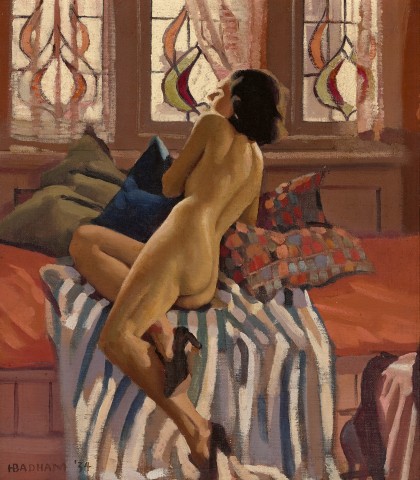NUDE MODEL, 1934
HERBERT BADHAM
oil on canvas on board
39.5 x 34.0 cm
signed and dated lower left: H. BADHAM ‘34
Private collection
Leonard Joel, Melbourne, 8 November 1989, lot 44 (as ‘The Model’)
Private collection
Leonard Joel, Melbourne, 31 July 1990, lot 246 (as ‘The Striped Cloth’)
Private collection, Melbourne
Thence by descent
Private collection, Melbourne
probably: Herbert Badham, Grosvenor Galleries, Sydney, May 1939, cat. 12 (as ‘Nude Study’)
Ashton, H., ‘Herbert Badham. Interesting Painter’, Sydney Morning Herald, Sydney, 25 May 1939, p. 4 (as ‘Nude Study’)
It seems more than likely that this painting is the work first exhibited as Nude Study, 1934 in Herbert Badham’s solo exhibition held in 1939 at Sydney’s Grosvenor Gallery. The exhibition was opened by Sir Marcus Clark and reviewed by the critic Howard Ashton who, after commenting on some of Badham’s compositions being deliberately overcrowded with detail, turns to Nude Model ‘as a work which shows what the artist can do when he is content to express things more simply and broadly.’1
Indeed, compared to works such as Travellers, 1933 or Hyde Park, 1933 which contain a wealth of detail as Badham strives to capture the complexity of everyday life, Nude Model exhibits a quiet classicism indicative of the training he had received at the Julian Ashton Art School. Under the tutelage George Lambert, Henry Gibbons and Julian Ashton, Badham, along with fellow students William Dobell, Douglas Dundas, Charles Meere and Rah Fizelle, had been encouraged to place a great emphasis on drawing which was seen as the foundation of all art while figure studies and landscape were the dominant subject matter.
Badham was born in Watsons Bay, Sydney in 1899 and upon completing his schooling, worked briefly as a clerk before signing up to the Royal Australian Navy in 1917. As a result, it was not until 1921 that he was able pursue his studies at the Julian Ashton Art School In 1932 where notably, just two years before he painted Nude Model, he was runner up to fellow student William Dobell for the prestigious New South Wales Travelling Scholarship.
Although Nude Model is a quietly classical composition, in typical Badham style, it is rich in information about the period in which it was painted. He has positioned his classically-posed model on a window seat beneath a narrow band of stained-glass casement windows which were typical of the 1920s bungalow. This referenced the Arts and Crafts movement and was the most common form of housing in the Sydney suburb of Vaucluse in the 1930s.2 Badham also records their exteriors in works such as The Travellers and South Head, 1935. It would seem highly possible that this is the artist’s own home, as he was living in the area at this time. His interest in geometry and perspective which was to become a major feature of his work during the fifties is also beginning to surface here, as the angle of the model’s legs echoes the angle of the abstract shapes in the stained-glass window.
The model’s identity has yet to be established but it appears to be the same person as portrayed in the work The New Scarf, also from 1934. Another unifying factor for works of this period is Badham’s inclusion of fabric. Here he uses the striped cloth and coloured cushion against the abstracted window pattern, while in Breakfast Piece, 1936 (Art Gallery of New South Wales), the play of blue and white cloth, crockery and clothing creates a highly active surface, as does the art deco pattern of the women’s hats and men’s blazers in The Travellers. Apart from their competence, these early works by Badham are important in that they signify a break away from post-Heidelberg pastoral landscapes and record an interest in the immediate world of everyday Sydney.
1. Ashton, H., ‘Herbert Badham. Interesting Painter’, Sydney Morning Herald, Sydney, 25 May 1939, p. 4
2. See Raworth, B., Our Inter-war Houses: How to Recognise, Restore and Extend Houses of the 1920s and 1930s, National Trust of Australia (Victoria), Melbourne, 1991
CHRISTINE FRANCE
